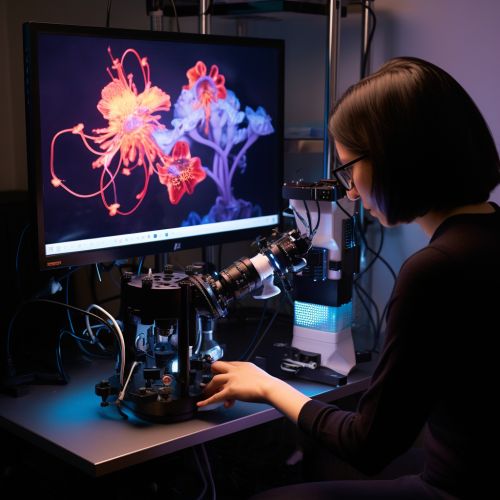In Vivo Imaging
Introduction
In vivo imaging is a non-invasive technique used to monitor biological processes and interactions at the cellular and molecular level within living organisms. The term "in vivo" is derived from Latin, meaning "within the living", and is used in contrast to "in vitro" (outside the living) and "ex vivo" (out of the living). In vivo imaging provides a crucial bridge between traditional laboratory assays and clinical studies, allowing researchers to study the complex biological systems in a more holistic and integrated manner.


Types of In Vivo Imaging Techniques
There are several types of in vivo imaging techniques, each with its own advantages and limitations. These include:
Optical Imaging
Optical imaging is a technique that uses light to probe biological tissues. It includes methods such as fluorescence imaging, bioluminescence imaging, and near-infrared imaging. These techniques are relatively inexpensive, easy to use, and capable of high-resolution imaging. However, they are limited by the depth of penetration, as light is rapidly scattered and absorbed by biological tissues.
Magnetic Resonance Imaging (MRI)
Magnetic Resonance Imaging (MRI) is a non-invasive imaging technique that uses a strong magnetic field and radio waves to generate detailed images of the inside of the body. It is particularly useful for imaging soft tissues and organs like the brain, heart, and muscles. MRI provides excellent spatial resolution and contrast between different types of tissues, but it is relatively expensive and requires a long imaging time.
Positron Emission Tomography (PET)
Positron Emission Tomography (PET) is a nuclear imaging technique that uses radioactive tracers to visualize metabolic processes in the body. It is commonly used in oncology to detect cancerous tumors, as well as in neurology and cardiology. PET provides excellent sensitivity and allows for quantitative imaging, but it involves exposure to ionizing radiation and requires a cyclotron for tracer production.
Computed Tomography (CT)
Computed Tomography (CT) is an imaging technique that uses X-rays to create detailed cross-sectional images of the body. It is commonly used to detect and diagnose diseases, guide interventions, and monitor therapy. CT provides good spatial resolution and is fast and widely available, but it involves exposure to ionizing radiation.
Ultrasound Imaging
Ultrasound imaging, also known as sonography, is a technique that uses high-frequency sound waves to produce images of the inside of the body. It is commonly used in obstetrics and gynecology to monitor the development of the fetus, as well as in cardiology and radiology. Ultrasound is safe, non-invasive, and real-time, but it is limited by the acoustic properties of different tissues.
Applications of In Vivo Imaging
In vivo imaging has a wide range of applications in both preclinical research and clinical practice. These include:
Drug Discovery and Development
In vivo imaging plays a crucial role in the drug discovery and development process. It allows researchers to monitor the distribution, metabolism, and efficacy of drugs in animal models, providing valuable information for the design and optimization of drug candidates. In addition, in vivo imaging can be used to assess the toxicity and side effects of drugs, contributing to the safety evaluation of new drugs.
Disease Diagnosis and Monitoring
In vivo imaging is widely used in the diagnosis and monitoring of various diseases. For example, MRI and CT can be used to detect tumors, strokes, and other abnormalities in the body, while PET can be used to assess the metabolic activity of tumors and the function of organs. In addition, in vivo imaging can be used to monitor the progression of diseases and the response to treatment, providing valuable information for patient management.
Basic Research
In vivo imaging is a powerful tool for basic research in biology and medicine. It allows researchers to study the function of genes, the behavior of cells, and the interaction of molecules in living organisms, providing insights into the mechanisms of diseases and the processes of life. For example, in vivo imaging can be used to track the migration of immune cells, the spread of viruses, and the signaling of neurons.
Future Perspectives
With the rapid advances in technology and the increasing understanding of biological systems, in vivo imaging is expected to play an even more important role in the future. New imaging techniques and probes are being developed to improve the resolution, sensitivity, and specificity of in vivo imaging. For example, molecular imaging, which combines the principles of molecular biology and in vivo imaging, is a promising field that aims to visualize and quantify the molecular processes in living organisms.
In addition, there is a growing interest in the integration of different imaging techniques, known as multimodal imaging, to overcome the limitations of individual techniques and provide a more comprehensive view of biological systems. For example, PET/MRI and PET/CT are hybrid imaging techniques that combine the advantages of PET and MRI or CT, providing both functional and anatomical information.
Furthermore, the application of artificial intelligence and machine learning in in vivo imaging is a hot topic of research. These technologies can be used to automate the image analysis process, improve the accuracy of diagnosis, and predict the outcome of diseases, revolutionizing the field of in vivo imaging.
